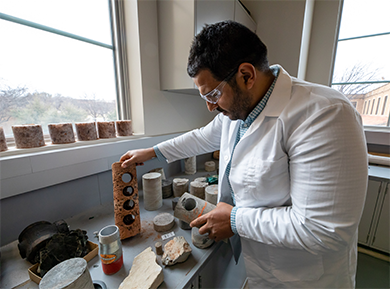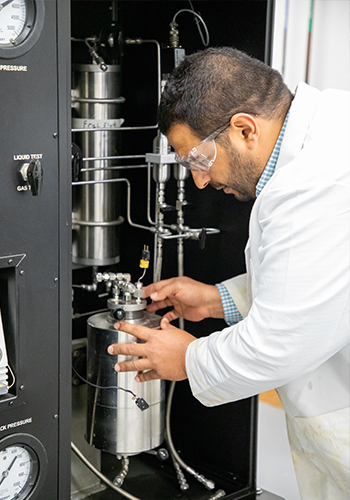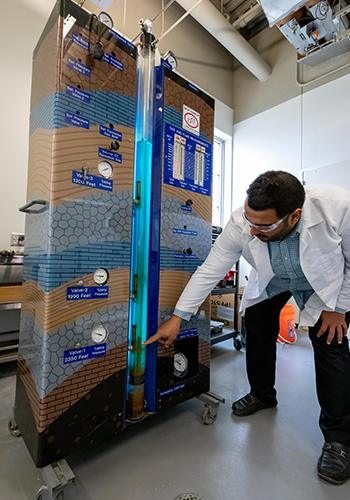EOR Research
Our EOR research focuses on shale oil and gas reservoirs. We have conducted a significant work on gas injection to enhance oil and condensate recovery. In particular, we have proposed and developed licensed huff-n-puff gas injection technology which has been accepted and widely used in the industry. Currently, we are further optimizing technology.

Surfactants as additives in fracturing fluid may reduce formation damage by fracturing fluid and increase oil and gas recovery from shale and tight reservoirs. The current research includes EOR mechanisms, surfactant screening, simulation analysis of laboratory experiments, and design of field-scale projects. Air has immense resources and high injectivity, and air injection may also have a thermal effect to enhance oil recovery. Currently, we are exploring EOR potential of air injection and studying the thermal cracking phenomenon.
 |
 |
Chemical additives in fracturing fluid may increase formation flow capability through dissolving solids, generating fractures, or removing formation damage. Currently, we are investigating the chemical additives which may stimulate shale and tight formation to enhance oil and gas recovery. This work is also extended to study the fluid-rock interactions.
We are also developing technologies to design the flow back of fracturing fluid, well spacing, optimized fracturing. In addition, we are also working on chemical EOR methods in producing heavy oil reservoirs where thermal methods are not applicable or economical.
Faculty:
Selected recent publications:
- Sheng, J.J. 2022. Evaluation of EOR potential of energized fluid fracturing – From an energy perspective, Fuel, 307, 121856.
- Tatsipie, N.R.K., Sheng, J.J. 2022. Deep learning-based sensitivity analysis of the effect of completion parameters on oil production, Journal of Petroleum Science and Engineering, 209, 109906.
- Sheng, J.J. 2019. Enhanced Oil Recovery in Shale and Tight Reservoirs, Elsevier, to be republished at the end of 2019.
- Sheng, J.J. 2011. Modern Chemical Enhanced Oil Recovery: Theory and Practice, Elsevier, Burlington, MA 01803, USA.
- Wijaya, N., Sheng, J.J. 2019. Shut-In Effect in Removing Water Blockage in Shale-Oil Reservoirs With Stress-Dependent Permeability Considered, SPEREE, 1-16, online, SPE-195696-PA.
- Tangirala, S., Sheng, J.J., 2019. Investigation of oil production and flowback in hydraulically-fractured water-wet formations using the Lab-on-a-Chip method, Fuel, 254, 115543.
- Yang, L., Sheng, J.J. 2019. Feasibility of Using the Frank−Kamenetskii Theory to Predict the Spontaneous Ignition of the Crude Oil−Sand Mixture, Energy Fuels, 33, 4816−4825.
- Sheng, J.J. 2018. Discussion of shale rock wettability and the methods to determine it, Asia Pacific Journal of Chemical Engineering, e2263, https://doi.org/10.1002/apj.2263
- Sharma, S. and Sheng, J.J. 2018. Comparison of huff-n-puff gas injection and solvent injection in large-scale shale gas condensate reservoirs, Journal of Natural Gas Science and Engineering 52, 434–453.
- Sheng, J.J. 2017. Performance Analysis of Chemical Flooding in Fractured Shale and Tight Reservoirs, Asia Pacific Journal of Chemical Engineering, 13(1), e2147; https://doi.org/10.1002/apj.2147
- Li, L., Zhang, Y., and Sheng, J.J. 2017. Effect of the Injection Pressure on Enhancing
Oil Recovery in Shale Cores during the CO2 Huff-n-Puff Process When It Is above and
below the Minimum Miscibility Pressure. Energy Fuels, 31, 3856−3867.
Bob L. Herd Department of Petroleum Engineering
-
Address
Bob L. Herd Department of Petroleum Engineering | Box 43111 | Lubbock, TX 79409-3111 -
Phone
806.742.3573 -
Email
webmaster.coe@ttu.edu
